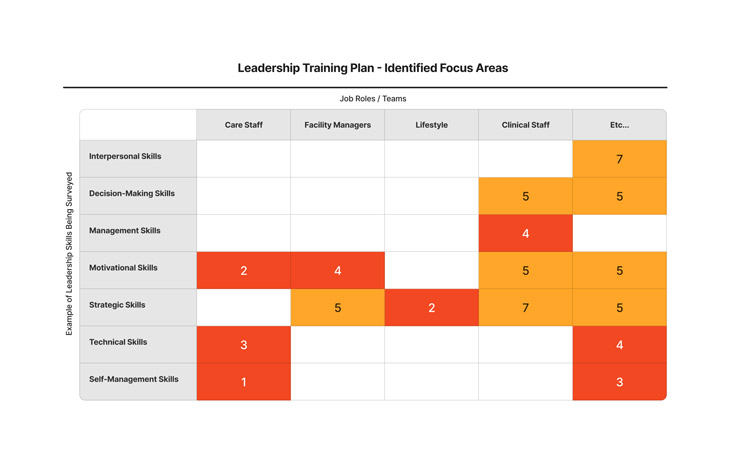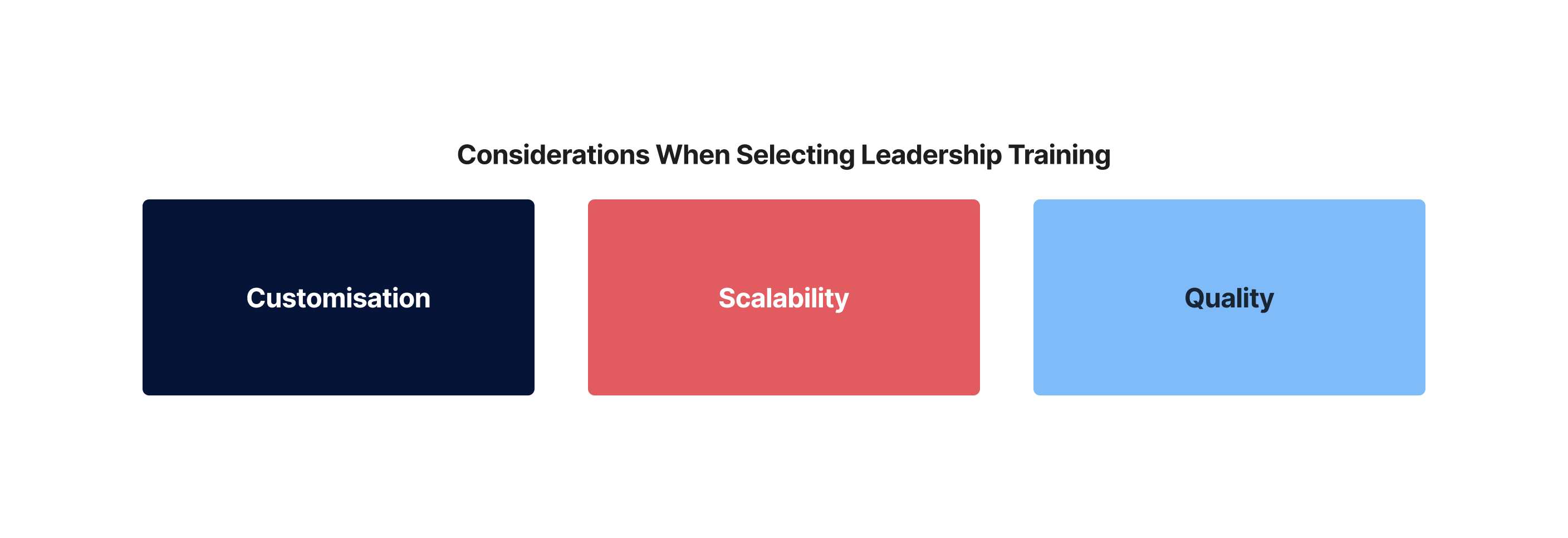Leadership development is a cornerstone for the success of healthcare organisations. As a Learning and Development Coordinator, you play a pivotal role in shaping the leaders of tomorrow. This "Training Requirement" aims to guide you through the process of developing a robust leadership training program, tailored to the unique needs of an Australian healthcare worker or professional.
Performing a Leadership Needs Analysis
Before diving into training program development, it's crucial to identify the specific leadership skills and competencies that need improvement. A needs analysis can help you pinpoint these areas.
There are a number of ways to conduct a needs analysis which can be broadly grouped into three categories:
- a gap analysis,
- learner identified need, or
- the anticipation of future needs.
However, the methods to collect data or actually complete the needs analysis are wide and varied. “Methods for assessing learner needs can include reviewing the literature, benchmarking, reviewing documents, seeker learner input, and other data collection methods” (Pilcher, 2016).
Steps to Conduct a Leadership Skills Needs Analysis
Step 1: Perform a Gap Analysis
The first thing to be mindful of is that your team will already have an existing knowledge base around leadership. Hence, step one is conducting a gap analysis.
-1.jpg)
As you can see from the diagram above, there are leadership skills where this healthcare team is already performing very well and don't require further training. But, most importantly, we're now much clearer about where the knowledge gaps might be.
The skills and elements you evaluate are entirely up to you, and should be based on your organisation's service environment. Here are a few examples to get you started.
| Skill | Key Elements |
| Interpersonal Skills |
|
| Decision-Making Skills |
|
| Management Skills |
|
| Motivational Skills |
|
| Strategic Skills |
|
| Technical Skills |
|
| Self-Management Skills |
|
Step 2: Isolate the Gaps
Once you've completed the process above, you will be more easily able to isolate the areas that need your attention (and should be the focus of your educational activities).

As you can see from the diagram above, the training needs of each job role or team differ, and some roles need very little training overall.
Step 3: Collect Additional Data/Insights
- Consult Stakeholders: Interview managers, team leaders, and even frontline staff to understand what leadership qualities are lacking. This will provide a holistic view of the leadership landscape in your organisation.
- Review Performance Metrics: Examine key performance indicators (KPIs) related to leadership such as staff turnover rates, patient, client or resident satisfaction, and quality indicators. These metrics can offer quantitative insights into areas that may benefit from leadership development.
- Conduct Surveys: Use anonymous surveys to gather staff opinions on leadership effectiveness. This qualitative data can reveal underlying issues that may not be immediately obvious.
You're almost at the point where you can begin to write the training plan and identify the relevant educational activities that you will provide your team as part of this training requirement. However, before you do this, it's best to measure the pre-training confidence or knowledge level of your team. This will help you demonstrate the ROI and impact of your educational program.
Methods to Measure Staff Confidence Prior to Training
Measuring staff confidence before the training program can serve as a baseline for assessing the program's effectiveness later on. As with all training, we simply don't want to be assigning learning for the sake of it; we must measure the outcomes! Additionally, performing this type of pre-training research will more clearly highlight the micro-gaps that exist, ensuring the program you put in place is more targeted to the actual need.
There are a number of ways you can gain insight into the current confidence and competence level of your workforce.
| Method | Description |
|---|---|
| Self-Assessment Questionnaires | Staff rate their own leadership skills and confidence levels. This method is quick and can be easily administered to a large group. |
| 360-Degree Feedback | Collect feedback from peers, subordinates, and supervisors. This provides a well-rounded view of an individual's leadership capabilities and areas for improvement. |
| Pre-Training Interviews | Conduct one-on-one interviews to gauge individual confidence levels. While time-consuming, this method offers in-depth insights. |
Example Leadership Survey
Surveying is often the easiest method to conduct both the pre and post-training measurement of competence and knowledge. Here is a sample set of six survey questions you could use to evaluate the skill of leadership.
-
How confident are you in your ability to lead a team through a challenging project?
- Not confident at all
- Somewhat confident
- Confident
- Very confident
- Extremely confident
-
To what extent do you feel comfortable making decisions that impact your team without consulting others?
- Not comfortable at all
- Somewhat comfortable
- Comfortable
- Very comfortable
- Extremely comfortable
-
How well do you think you understand and apply leadership principles such as delegation, motivation, and communication?
- Poor understanding and application
- Below average understanding and application
- Average understanding and application
- Good understanding and application
- Excellent understanding and application
-
How confident are you in your ability to resolve conflicts within your team effectively?
- Not confident at all
- Somewhat confident
- Confident
- Very confident
- Extremely confident
-
How well-equipped do you feel to mentor or coach junior staff members in their professional development?
- Not equipped at all
- Somewhat equipped
- Well-equipped
- Very well-equipped
- Extremely well-equipped
-
How comfortable are you in taking the initiative to propose new projects or improvements within your organisation?
- Not comfortable at all
- Somewhat comfortable
- Comfortable
- Very comfortable
- Extremely comfortable
Leadership Educational Activities
Once you have a clear understanding of the needs and baseline confidence levels, you can proceed to design or select a training program.

- Customisation: Choose a program that can be tailored to the specific needs of your organisation. Off-the-shelf solutions may not address the unique challenges your healthcare facility faces. You might even need to make your own!
- Scalability: Ensure the program can be scaled up to accommodate more participants as and if needed. This is particularly important for growing organisations. Using an web and mobile based Learning Management System like Ausmed can help with this.
- Quality: Opt for programs that align with relevant Australian healthcare standards or are provided by reputable publishers. This adds credibility and ensures that the training meets industry standards. Staff also prefer learning from reputable and well known brands too.
A blended approach, combining face-to-face and online learning, often yields the best results. This hybrid model caters to different learning styles and offers the best of both worlds.
Ausmed's Leadership Modules
Organisations using Ausmed's workforce capability products including the Ausmed Library and the Ausmed LMS can benefit from being able to access up to 1,250 pre-built training modules straight out of the box. Here are a few that support training relating to leadership.
- Leadership Skills in Action
- Leadership Character
- Governance, Leadership and Culture
- Leadership Lesson: How to Stay Calm, Confident and Assured
Measuring Staff Confidence After Training
Post-training assessments should mirror the pre-training methods to provide a comparative analysis. This will help you evaluate the effectiveness of the training program in boosting staff confidence and leadership skills.
Reporting the Results to the Executive
Compile the data into a comprehensive report that includes:
- Summary of key findings
- Comparative analysis of pre and post-training confidence levels
- Recommendations for future training initiatives
- Case studies or testimonials from participants
Presenting this data to the executive team will not only demonstrate the program's effectiveness but also help secure support for future training endeavours.
If you've completed a pre and post education staff survey then including the results in your report is essential! Be sure to compare the knowledge and confidence levels before and after the training.
References
- Smith, J. (2020). 'Leadership Development in Healthcare', Australian Journal of Healthcare Management, vol. 15, no. 2, pp. 34-45.
- Brown, A. & Williams, C. (2019). 'Effective Training Programs in Healthcare', Journal of Australian Medical Education, vol. 12, no. 3, pp. 67-78.
- Pilcher, J, 2016, Learning Needs Assessment, Journal for Nurses in Professional Development, vol 32, no 4, 185-191



